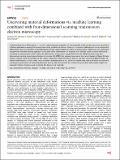| dc.contributor.author | Shi, Chuqiao | |
| dc.contributor.author | Cao, Michael C. | |
| dc.contributor.author | Rehn, Sarah M. | |
| dc.contributor.author | Bae, Sang-Hoon | |
| dc.contributor.author | Kim, Jeehwan | |
| dc.contributor.author | Jones, Matthew R. | |
| dc.contributor.author | Muller, David A. | |
| dc.contributor.author | Han, Yimo | |
| dc.date.accessioned | 2024-02-27T21:08:21Z | |
| dc.date.available | 2024-02-27T21:08:21Z | |
| dc.date.issued | 2022-05-18 | |
| dc.identifier.issn | 2057-3960 | |
| dc.identifier.uri | https://hdl.handle.net/1721.1/153596 | |
| dc.description.abstract | Understanding lattice deformations is crucial in determining the properties of nanomaterials, which can become more prominent in future applications ranging from energy harvesting to electronic devices. However, it remains challenging to reveal unexpected deformations that crucially affect material properties across a large sample area. Here, we demonstrate a rapid and semi-automated unsupervised machine learning approach to uncover lattice deformations in materials. Our method utilizes divisive hierarchical clustering to automatically unveil multi-scale deformations in the entire sample flake from the diffraction data using four-dimensional scanning transmission electron microscopy (4D-STEM). Our approach overcomes the current barriers of large 4D data analysis without a priori knowledge of the sample. Using this purely data-driven analysis, we have uncovered different types of material deformations, such as strain, lattice distortion, bending contour, etc., which can significantly impact the band structure and subsequent performance of nanomaterials-based devices. We envision that this data-driven procedure will provide insight into materials’ intrinsic structures and accelerate the discovery of materials. | en_US |
| dc.language.iso | en | |
| dc.publisher | Springer Science and Business Media LLC | en_US |
| dc.relation.isversionof | 10.1038/s41524-022-00793-9 | en_US |
| dc.rights | Creative Commons Attribution | en_US |
| dc.rights.uri | https://creativecommons.org/licenses/by/4.0/ | en_US |
| dc.source | Springer Nature | en_US |
| dc.subject | Computer Science Applications | en_US |
| dc.subject | Mechanics of Materials | en_US |
| dc.subject | General Materials Science | en_US |
| dc.subject | Modeling and Simulation | en_US |
| dc.title | Uncovering material deformations via machine learning combined with four-dimensional scanning transmission electron microscopy | en_US |
| dc.type | Article | en_US |
| dc.identifier.citation | Shi, C., Cao, M.C., Rehn, S.M. et al. Uncovering material deformations via machine learning combined with four-dimensional scanning transmission electron microscopy. npj Comput Mater 8, 114 (2022). | en_US |
| dc.contributor.department | Massachusetts Institute of Technology. Department of Mechanical Engineering | |
| dc.relation.journal | npj Computational Materials | en_US |
| dc.eprint.version | Final published version | en_US |
| dc.type.uri | http://purl.org/eprint/type/JournalArticle | en_US |
| eprint.status | http://purl.org/eprint/status/PeerReviewed | en_US |
| dc.date.updated | 2024-02-27T20:47:51Z | |
| dspace.orderedauthors | Shi, C; Cao, MC; Rehn, SM; Bae, S-H; Kim, J; Jones, MR; Muller, DA; Han, Y | en_US |
| dspace.date.submission | 2024-02-27T20:47:56Z | |
| mit.journal.volume | 8 | en_US |
| mit.journal.issue | 1 | en_US |
| mit.license | PUBLISHER_CC | |
| mit.metadata.status | Authority Work and Publication Information Needed | en_US |
